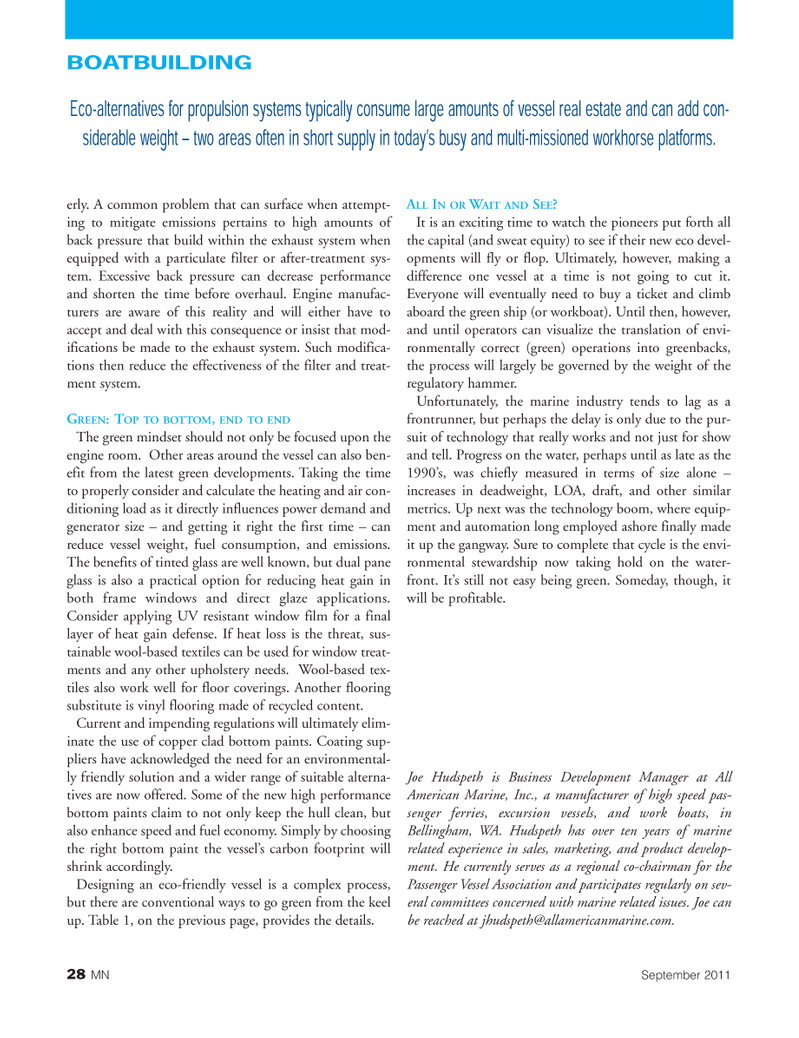
Page 28: of Marine News Magazine (September 2011)
The Environmental Edition
Read this page in Pdf, Flash or Html5 edition of September 2011 Marine News Magazine
28MNSeptember 2011erly. A common problem that can surface when attempt- ing to mitigate emissions pertains to high amounts of back pressure that build within the exhaust system when equipped with a particulate filter or after-treatment sys- tem. Excessive back pressure can decrease performance and shorten the time before overhaul. Engine manufac- turers are aware of this reality and will either have to accept and deal with this consequence or insist that mod-ifications be made to the exhaust system. Such modifica- tions then reduce the effectiveness of the filter and treat- ment system.GREEN: TOPTOBOTTOM , ENDTOEND The green mindset should not only be focused upon the engine room. Other areas around the vessel can also ben- efit from the latest green developments. Taking the time to properly consider and calculate the heating and air con- ditioning load as it directly influences power demand and generator size ? and getting it right the first time ? can reduce vessel weight, fuel consumption, and emissions. The benefits of tinted glass are well known, but dual pane glass is also a practical option for reducing heat gain in both frame windows and direct glaze applications. Consider applying UV resistant window film for a final layer of heat gain defense. If heat loss is the threat, sus- tainable wool-based textiles can be used for window treat- ments and any other upholstery needs. Wool-based tex- tiles also work well for floor coverings. Another flooring substitute is vinyl flooring made of recycled content. Current and impending regulations will ultimately elim- inate the use of copper clad bottom paints. Coating sup-pliers have acknowledged the need for an environmental- ly friendly solution and a wider range of suitable alterna-tives are now offered. Some of the new high performance bottom paints claim to not only keep the hull clean, butalso enhance speed and fuel economy. Simply by choosing the right bottom paint the vessel?s carbon footprint will shrink accordingly. Designing an eco-friendly vessel is a complex process, but there are conventional ways to go green from the keel up. Table 1, on the previous page, provides the details. ALLINOR WAITAND SEE?It is an exciting time to watch the pioneers put forth all the capital (and sweat equity) to see if their new eco devel- opments will fly or flop. Ultimately, however, making a difference one vessel at a time is not going to cut it. Everyone will eventually need to buy a ticket and climb aboard the green ship (or workboat). Until then, however, and until operators can visualize the translation of envi- ronmentally correct (green) operations into greenbacks, the process will largely be governed by the weight of the regulatory hammer. Unfortunately, the marine industry tends to lag as a frontrunner, but perhaps the delay is only due to the pur- suit of technology that really works and not just for show and tell. Progress on the water, perhaps until as late as the 1990?s, was chiefly measured in terms of size alone ? increases in deadweight, LOA, draft, and other similar metrics. Up next was the technology boom, where equip- ment and automation long employed ashore finally made it up the gangway. Sure to complete that cycle is the envi- ronmental stewardship now taking hold on the water- front. It?s still not easy being green. Someday, though, it will be profitable. Joe Hudspeth is Business Development Manager at All American Marine, Inc., a manufacturer of high speed pas- senger ferries, excursion vessels, and work boats, in Bellingham, WA. Hudspeth has over ten years of marine related experience in sales, marketing, and product develop- ment. He currently serves as a regional co-chairman for the Passenger Vessel Association and participates regularly on sev- eral committees concerned with marine related issues. Joe can be reached at [email protected]. BOATBUILDING Eco-alternatives for propulsion systems typically consume large amounts of vessel real estate and can add con- siderable weight ? two areas often in short supply in today?s busy and multi-missioned workhorse platforms. MN#9 (18-31):MN 2011 Layouts 9/6/2011 12:02 PM Page 28

 27
27

 29
29
